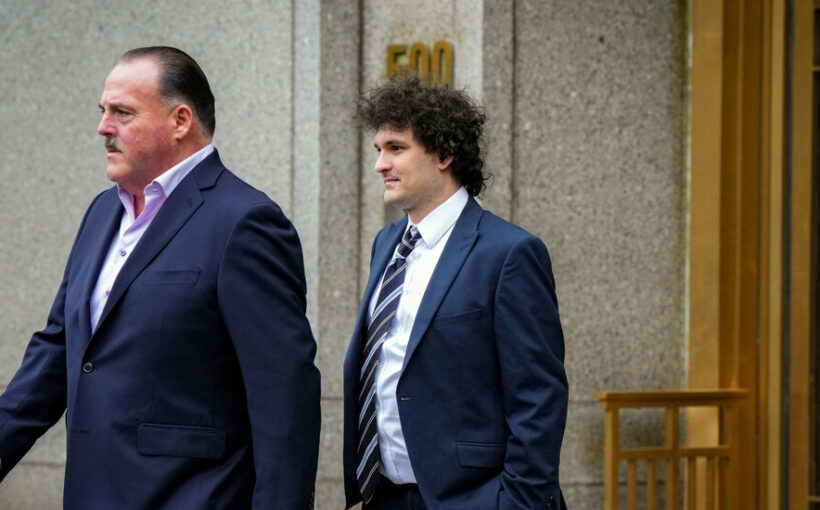Federal prosecutors added a foreign bribery charge to the growing list of crimes already pending against the FTX founder Sam Bankman-Fried, according to a new indictment filed in federal court in Manhattan on Tuesday.
Federal prosecutors said that in 2021 Mr. Bankman-Fried instructed those working for him to pay a bribe of $40 million to one or more Chinese officials to help unfreeze trading accounts maintained by Alameda Research, FTX’s sister company, that held about $1 billion in cryptocurrencies.
The bribe money was paid to the Chinese officials in cryptocurrency, the document said. The indictment said the effort to pay off the unnamed Chinese officials was successful in getting the trading accounts unfrozen.
The bribery charge was brought under the Foreign Corrupt Business Practices Act, a federal law used by the authorities to go after big corporations for paying bribes to operate in other countries.
With the foreign bribery charge, federal prosecutors have now charged Mr. Bankman-Fried with 13 criminal counts, including securities fraud, money laundering and violating campaign finance laws. The mounting charges against Mr. Bankman-Fried, 31, not only adds years to the potential prison time he faces if convicted, but could put more pressure on him to take a guilty plea.
What to Know About the Collapse of FTX
What is FTX? FTX is a now bankrupt company that was one of the world’s largest cryptocurrency exchanges. It enabled customers to trade digital currencies for other digital currencies or traditional money; it also had a native cryptocurrency known as FTT. The company, based in the Bahamas, built its business on risky trading options that are not legal in the United States.
Who is Sam Bankman-Fried? He is the 30-year-old founder of FTX and the former chief executive of FTX. Once a golden boy of the crypto industry, he was a major donor to the Democratic Party and known for his commitment to effective altruism, a charitable movement that urges adherents to give away their wealth in efficient and logical ways.
How did FTX’s troubles begin? Last year, Changpeng Zhao, the chief executive of Binance, the world’s largest crypto exchange, sold the stake he held in FTX back to Mr. Bankman-Fried, receiving a number of FTT tokens in exchange. In November, Mr. Zhao said he would sell the tokens and expressed concerns about FTX’s financial stability. The move, which drove down the price of FTT, spooked investors.
What led to FTX's collapse? Mr. Zhao’s announcement drove down the price and spooked investors. Traders rushed to withdraw from FTX, causing the company to have a $8 billion shortfall. Binance, FTX’s main rival, offered a loan to save the company but later pulled out, forcing FTX to file for bankruptcy on Nov. 11.
Why was Mr. Bankman-Fried arrested? FTX’s collapse kicked off investigations by the Justice Department and the Securities and Exchange Commission focused on whether FTX improperly used customer funds to prop up Alameda Research, a crypto trading platform that Mr. Bankman-Fried had helped start. On Dec. 12, Mr. Bankman-Fried was arrested in the Bahamas for lying to investors and committing fraud. The day after, the S.E.C. also filed civil securities fraud charges.
A spokesman for Mr. Bankman-Fried did not have an immediate comment on the newest charge. Mr. Bankman-Fried was freed after posting bail but is confined to his parents’ home in Palo Alto, Calif.
Federal prosecutors in Manhattan filed the first set of criminal charges against Mr. Bankman-Fried in December, a month after the big cryptocurrency exchange collapsed into bankruptcy. The top charge facing Mr. Bankman-Fried is that he misappropriated billions of dollars in customer deposits for his own personal use and to make up for hefty losses incurred by Alameda.
The indictment filed by prosecutors said the bribe money was paid to unfreeze trading accounts maintained by Alameda.
The authorities said that in early 2021, Chinese officials froze the money in those accounts, which were held in two of China’s largest cryptocurrency exchanges. The accounts had been frozen in connection with an investigation into one of Alameda’s trading partners.
Mr. Bankman-Fried came up with the plan to pay bribes, prosecutors said, after other efforts to unfreeze the money were unsuccessful, including hiring lawyers to lobby Chinese officials and creating fraudulent accounts in an attempt to deceive the Chinese authorities.
The Aftermath of FTX’s Downfall
The spectacular collapse of the crypto exchange in November has left the industry stunned.
The bribe money, according to the federal prosecutors, was paid in at least two parts, with the first taking place in November 2021.
The indictment said that after Mr. Bankman-Fried received confirmation that the accounts were unfrozen, the rest of the bribe money was paid. The unfrozen funds were then used to fuel additional trading at Alameda.
The charging document does not identity the Chinese officials or the employees who assisted Mr. Bankman-Fried in paying the bribe. But it said at least one of the Alameda employees was in the United States.
Alameda, which Mr. Bankman-Fried co-founded in 2017, was originally based in Berkeley, Calif., but soon moved to Hong Kong and continued to operate from there until FTX’s implosion in November.
The authorities have said that Mr. Bankman-Fried and his top lieutenants concealed from customers, investors and lenders some of the details of the close relationship between Alameda and FTX. In particular, they did not disclose that Alameda was tapping into customer money at will to make trades and patch up any losses it incurred.
To date, three former executives who worked closely with Mr. Bankman-Fried have pleaded guilty and are cooperating with the authorities. Among them is Caroline Ellison, who was a leader at Alameda.
Source: Read Full Article
